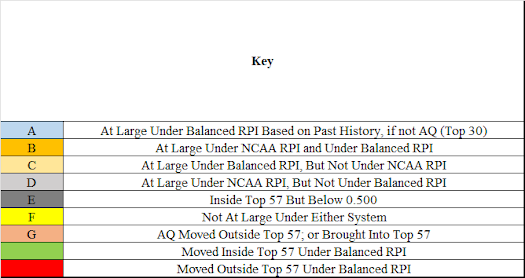This is my eighth weekly report for the 2023 season.
In the first table below, I show teams’ current RPI ratings, including showing teams in the history-based candidate groups as of this point in the season for NCAA Tournament #1 through #4 seeds and at large selections. (I do not show candidate groups for #6 through #8 seeds, as there is only one year of data for those groups, which I do not believe is enough precedent to establish reliable groups.)
In the other three tables, I show, using the actual results of games played through October 8 and simulated results for games not yet played (including simulated conference tournaments):
1. Teams’ simulated end-of-season ranks using the current NCAA RPI and my Balanced RPI;
2. Based on the current NCAA RPI, teams in candidate pools for NCAA Tournament #1, 2, 3, and 4 seeds and for at large selections and where they fit within the pools; and
3. Likely differences in at large selections for the NCAA Tournament if the Women’s Soccer Committee were to use the Balanced RPI rather than the current NCAA RPI. NOTE: It is too early to pay much attention to how specific teams compare under the two rating systems. Rather, what bears attention is how teams from the different regions and from Power 5 versus non-Power 5 conferences fare under the two systems.
The background for the information in the three tables is in 2023 Reports 1 through 4.
NOTE: Starting this week, I am using teams' current RPI ratings as the basis for simulating results of games not yet played, rather than using my pre-season simulated ratings.
Summarizing the likely differences in at large selections for the NCAA Tournament in changing from the current NCAA RPI to the Balanced RPI, derived from the last table below:
At Large Candidate Teams: Eight teams that are not at large candidates under the current NCAA RPI are candidates under the Balanced RPI. Of these, 1 is from the Middle, 0 from the North, 4 from the South, and 3 from the West regions. Seven are from Power 5 conferences and 1 is not. The 1 not from a Power 5 conference is an Automatic Qualifier.
No Longer Candidate Teams: Eight teams that are at large candidates (or Automatic Qualifiers) under the current NCAA RPI are not candidates under the Balanced RPI. Of these, 1 is from the Middle, 3 from the North, 3 from the South, and 1 from the West regions. None is from a Power 5 conference. Of these, 6 are Automatic Qualifiers. The other two likely would get at large positions under the current NCAA RPI.
Selected Teams: Five teams that either definitely (1 team) or likely (4 teams) are not at large selections under the current NCAA RPI likely are at large selections under the Balanced RPI. Of these, 1 is from the Middle, 0 from the North, 1 from the South, and 3 from the West regions. Four are from Power 5 conferences and 1 is not.
No Longer Selected Teams: Five teams that likely are at large selections under the current NCAA RPI likely are not at large selections under the Balanced RPI. Of these, 1 is from the Middle, 2 from the North, 2 from the South, and 0 from the West regions. None is from a Power 5 conference.
Current RPI Rankings
The first table below shows teams’ current RPI ranks, their strength of schedule contributor ranks, their opponents’ average RPI ranks, and their opponents’ average strength of schedule contributor ranks. These will help you see the differences between team RPI ranks and strength of schedule contributor ranks -- in an ideal rating system, those ranks should be the same, but under the current NCAA RPI they are not and often are not by a wide margin.
In addition, the table shows the same rank items for my Balanced RPI.
And, on the left, the table shows teams that are potential #1 through #4 seeds and at large selections, at this stage of the season, based on Committee decisions since 2007. The poorest ranked team in any candidate group is the poorest ranked team as of the current week that the Committee gave a positive decision to in its end of season decision process.
The second table shows average ranks for conferences, again allowing comparisons of average RPI ranks and average strength of schedule contributor ranks. The third table is similar, but is for geographic regions.
Simulated End-of-Season Ranks
Simulated NCAA Tournament Seed and At Large Selection Candidate Pools (based on current NCAA RPI)











Having trouble wrapping my head around the following. Last week there were teams that were outside the range of say being a #4 seed. However, this week as their RPI ranking got better, they are now in range. Seems like if they are in range for report 15…… they should be in range in report 14?.????
ReplyDeleteHere is the explanation: If a team is outside the range in any week, the team never has gotten the particular decision, in your case a #4 seed. So although they appear in the range this week, because they were outside the range in another week, the historic expectation is they will not get a #4 seed.
ReplyDelete